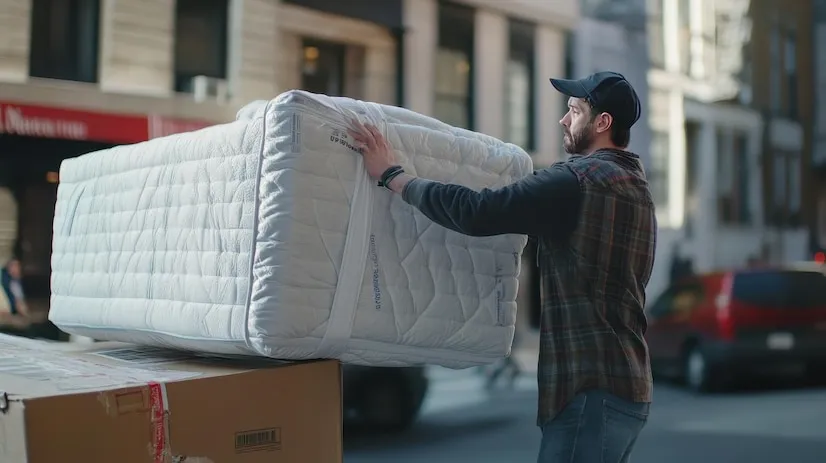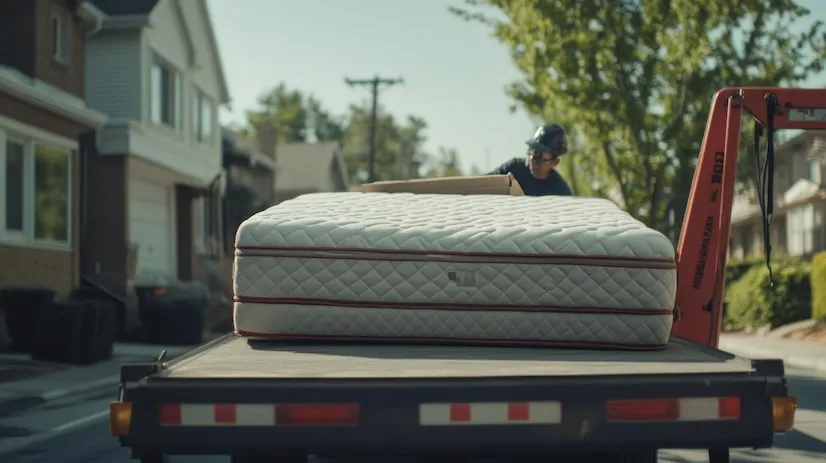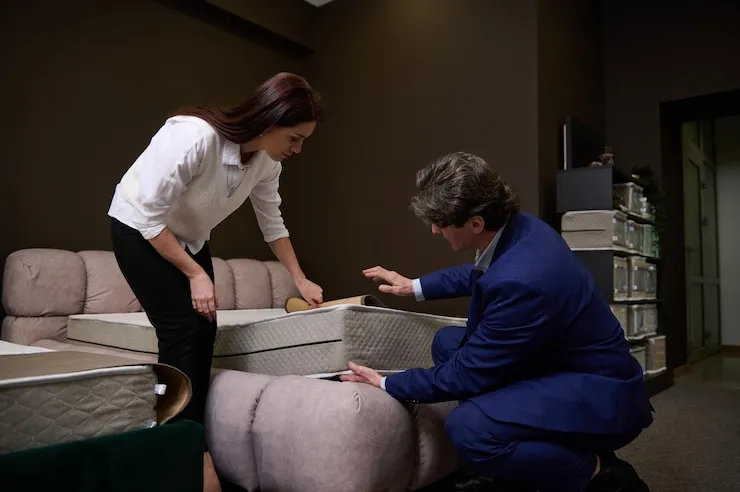
How to Transport a Mattress: Moving can be stressful, exhausting, and costly, especially when you’re handling large items like mattresses. Whether it’s family heirlooms, electronics, or furniture, ensuring everything is transported safely without being damaged is crucial. Among the list of challenging items to move, mattresses often stand out due to their size, shape, and structure. If you’re preparing for a move, you’ve probably asked yourself questions about the best way to manage mattress transportation.
Common concerns for tenants and homeowners looking to relocate include whether a storage unit is necessary or how to properly use mattress bags and a mattress cover. In this blog post, we’ll guide you through the essential tools and steps to make moving your mattress easier. You’ll find clear answers to your questions about transporting a mattress, helping to ensure a smooth and efficient move without unnecessary hassle.
What to Know Before Moving a Mattress
- Having a buddy to help is essential when moving a mattress.
- The weight of the mattress depends on its type:
- 45 pounds for a twin mattress
- 71 pounds for a queen-size mattress
- 90 pounds to 100 pounds for a King size memory foam mattress, California king mattress, or other specialized mattresses
- Moving a mattress alone can lead to:
- Physical injuries
- Strained muscles
- Nasty falls
- Always have a partner to help lift and move the mattress safely.
- Avoid tying the mattress to the roof of a car because it can expose the mattress to pollutants and elements, causing damage.
- It’s best to secure the mattress inside a truck or moving van for structural coverage during transport.
- Proper securing of the mattress ensures it stays safe during the move.
How to Move Your Mattress

Put your mattress into the mattress bag.
First, put your mattress into a mattress bag. Lay the mattress flat on the ground or against a wall, and with a partner’s help, slide the bag over it. Push out all the air, fold the flaps down, and seal the open ends with tape. If you find any small holes or rips, use extra tape to seal them.
Clear a path.
Before moving the mattress, make sure to clear a path to your transporting vehicle. Remove any objects or debris that might block the walkway or stairs, and verify that all doors are open and wide enough for the mattress to pass through when carried or wheeled on a dolly or hand truck. Once the way is clear, it’s time to prepare your transporting vehicle. Ensure the vehicle doors are open, and the interior is clear. Remove or push down the seats before attempting to move the mattress.
Lift the mattress.
When it’s time to lift the mattress, have one person on each side. Grab the bottom corners of the mattress and lift it together. Be sure to avoid lifting with your back, instead brace your abdominal core and power the lift using your legs. Once it’s lifted, place the mattress upright on a dolly or hand truck. If the mattress is floppy, secure it with cardboard to provide support. If the path to the vehicle includes stairs, stop at the top and carefully carry the mattress down, never trying to roll it downstairs.
Load the mattress into your vehicle.
To load the mattress into your vehicle, if you’re using a moving van or pickup truck, simply lift the mattress off the dolly and place it into the cargo hold. If you need to transport the mattress on top of a car or SUV, make sure it’s protected by a mattress bag. Be careful when placing the mattress on the roof or luggage rack, and check for any tears in the bag before securing it.
Secure the mattress.
Finally, when you’re ready to secure the mattress, follow the appropriate steps based on your vehicle type. For a moving truck, lay the mattress flat in the cargo space and use nylon ropes or ratchet straps to keep it in place. If you’re using a pickup truck, position the mattress flat in the truck bed, then tie it with nylon ropes or straps to prevent it from sliding. For a car or SUV, tie the mattress securely using nylon ropes or ratchet straps, especially if it lacks a luggage rack.
Drive slowly and carefully.
When you drive, do so slowly and carefully, especially with a mattress tied to the roof. Check periodically to ensure the mattress remains secure and take back roads when possible to avoid sharp turns or sudden stops that could cause the mattress to shift.
Equipment Needed for Moving a Mattress
When moving a mattress, having the right equipment can make the process easier and ensure safe delivery. You can rent some of the supplies from a moving rental company or purchase them online or in-store.
- Mattress Bags: A mattress bag is crucial for protecting your mattress from damage, dust, grime, and potential infestations during the move. You can find mattress bags at stores like Walmart, Target, Home Depot, Uhaul, and Amazon. Make sure the bag fits the size of your mattress.
- Dolly or Hand Truck: A dolly or hand truck is ideal for moving your mattress from the bedroom to the transporting vehicle and into your new home. You can rent these tools from local hardware stores or moving truck rental companies, making the task much easier.
- Ratchet Tie-Down Straps: To secure your mattress in the truck bed or moving van. Use a ratchet tie-down strap or a tie-down strap. These are great for locking the mattress in place and preventing it from shifting during transit.
- Nylon Rope: Another option to secure your mattress is a sturdy length of nylon rope. You can find this at most hardware stores, and it’s perfect for tying the mattress down if you’re using a pickup truck or SUV.
- Cardboard: If your mattress is on the flexible side, use a large flat piece of cardboard to stabilize it during transport. This will provide extra support and prevent the mattress from bending or getting damaged.
- Tape: Use strong, durable shipping or packing tape to seal the mattress bag. Shipping tape, masking tape, and duct tape have strong adhesives that are waterproof and will prevent moisture from entering the bag and damaging your mattress.
- Retractable Knife: A sharp reliable knife will be needed to cut open the mattress bag once you reach your destination. Be sure to handle it with care to avoid damaging the mattress.
- Tool Set: If the mattress is on a bed frame, a tool set with wrenches, screwdrivers, and Allen wrenches will help you disassemble the frame for easier transport.
- Sandwich Bags: To keep track of important parts like screws, nuts, and bolts when taking apart the bed frame, use sandwich bags to store them securely.
Tips for Safe Driving with a Mattress

- Test Drive: Before your trip, take a test drive around the block with the mattress strapped to your car to check for sturdiness. Adjust the ropes or straps if any shifting occurs.
- Avoid Highways: Instead of using highways, drive on back roads to reduce the risk of accidents. Driving slower allows for safer transport of the mattress.
- Safety Statistics: Between 2011 and 2014, AAA reported 39,000 injuries and over 500 deaths due to road debris, with 37% of deaths caused by swerving to avoid debris.
- Regular Checks: During your trip, stop periodically to check that the ropes or straps haven’t loosened due to wind or other elements.
- Professional Movers: If transporting a mattress in your car seems challenging. Consider hiring professional movers through a free moving company directory to ensure safe delivery.
Can Folding or Bending a Mattress Damage It?
Folding or bending a spring mattress can harm its structure. Leading to less comfortable sleep or, in severe cases, a ruined mattress. This is because the internal coils and frame of a spring mattress are not designed to flex in this way.
On the other hand, polyurethane-based memory foam mattresses, like Casper’s mattress-in-a-box, have remarkable flexibility and suppleness. These mattresses can be folded or rolled and will typically spring back to their original shape without damage. Similarly, latex mattresses can also be folded in half and will retake their original form within a few hours.
Conclusion
Moving a mattress can be a daunting task. But with the right preparation and tools, you can ensure it arrives at your new home safely and intact. Understanding the weight and structure of your mattress is crucial to avoid injuries and damage. Using proper equipment like mattress bags, dollies, and securing straps can simplify the process and protect your mattress from external elements. If in doubt, consider hiring professional movers to handle the transportation with expertise. With careful planning and attention to detail, you can make the mattress-moving process smooth and stress-free.
FAQ’s
Duration: Folding a mattress briefly, like for transport, is usually fine. However, leaving it folded too long can cause damage. Technique: If folding is needed, do it carefully and avoid sharp folds. Some mattresses are made to fold, so check the manufacturer’s instructions.
Mattress bags slip over your mattress, shielding it from pests, dirt, moisture, and germs during the move. Each mattress and box spring requires its bag. We suggest using mattress bags that have handles.
We advise against folding or bending your mattress, which can cause significant damage. Frequent folding can harm the coils, bend the border rods, and damage the foam encasement.



